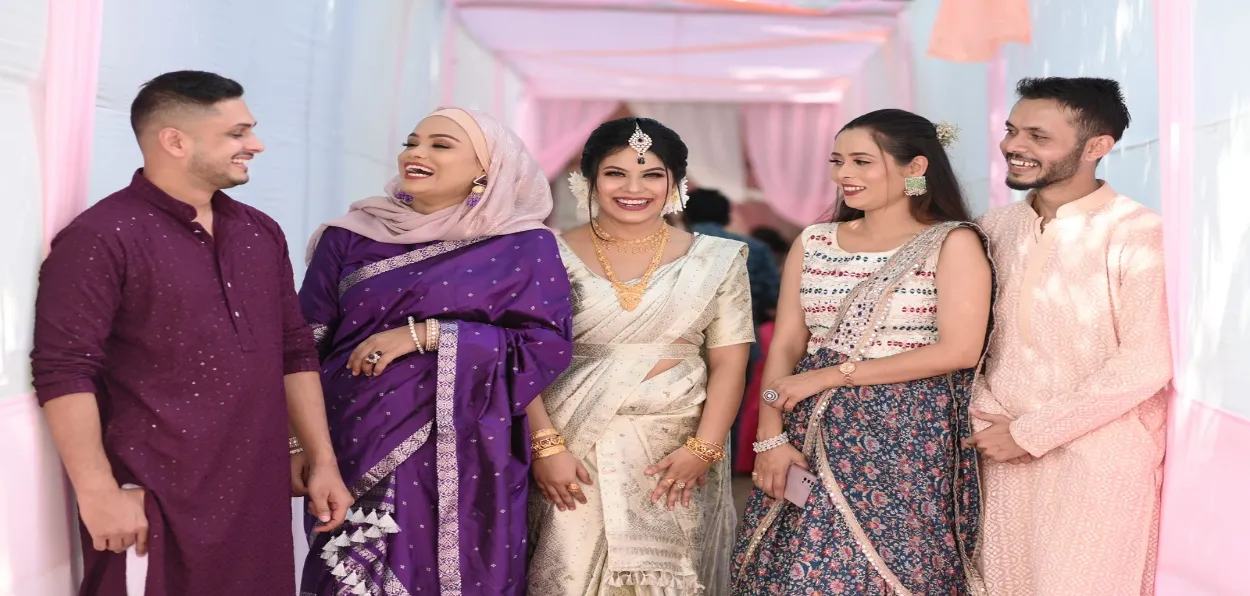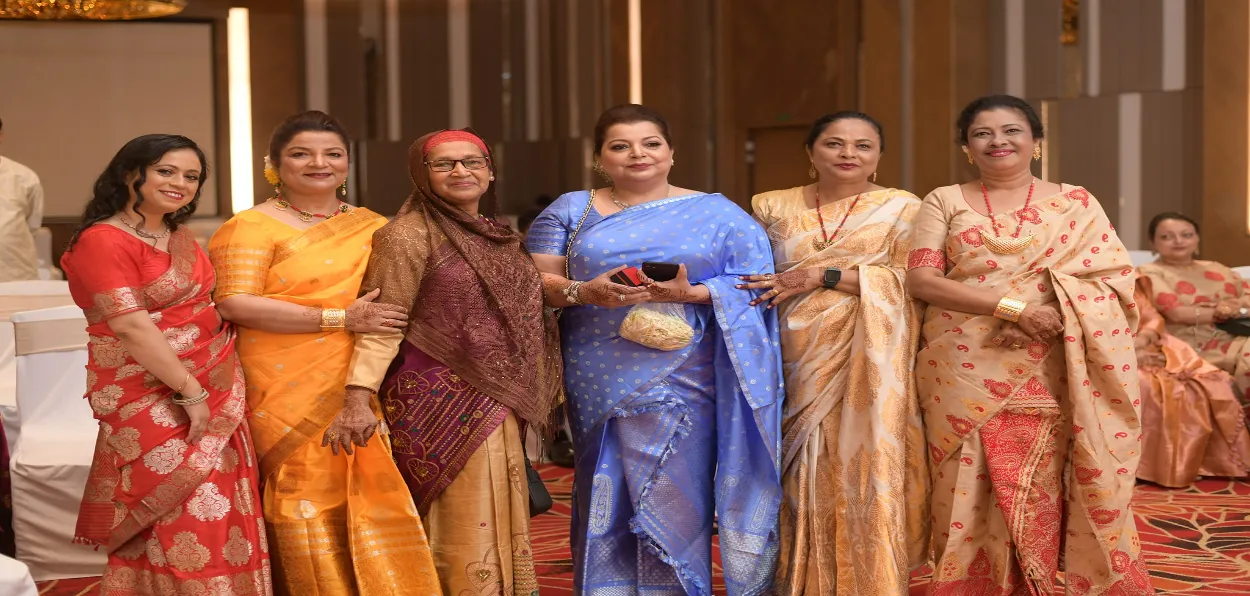
Zafri Mudasser Nofil
Marriages in Assamese Muslim society are mainly about Islamic customs but with some traditions common among Assamese Hindus closely entwined.
Arranged marriages comprise two main ceremonies Angothi pindhuwa or uroon (ring ceremony or mangni) followed by the nikaah. The groom's family visits the bride's place to formally ask for her hand. After the families of both sides agree on the marriage, a date is fixed for the ring ceremony, which usually takes place a few months before the wedding.
On that day, relatives of the groom including his parents go to the would-be bride's home and give her a gold ring, clothes, ornaments and sweets. The groom's party is treated to a sumptuous meal. Nowadays, in many cases, the groom also accompanies his parents. The juroon marks the beginning of the wedding festivities.
 Women relatives at the wedding in a Muslim family of Assam
Women relatives at the wedding in a Muslim family of Assam
It’s followed by the nikaah. However, it's preceded by a couple of short ceremonies. One is a milad sharif in which a maulvi recites some verses from the Quran and prays for the smooth conduct of the marriage. A feast follows and the usual food items offered at these gatherings are pulao, meat curry, and meat roast.
Murot tel diya (putting oil on the hair of the bride and groom) is the other ritual before the nikaah. This practice is influenced by maah halodhi diya (adorning the bride and groom with turmeric and lentil paste) of Assamese Hindu marriages. Oil is applied to the hair of the bride and a paste of lentils and turmeric on her body and she is given a ceremonial bath. The groom also goes through the same process. This practice is, however, not prevalent among all Muslims of Assam. Ballads called Biya naam (folk songs at weddings) are also sung in many marriages, particularly in rural areas.
It is very interesting to note that the brides wear resplendent traditional Assamese dress-- mekhela chadors both in the nikaah as well as the reception ceremonies while the groom dons a sherwani and a paguri (turban) on the day of the nikaah and usually a western suit on the day of the reception. This dress code can be attributed to the fact that when the Muslims first came to Assam, they married local Assamese women.
An Assamese Muslim bride seeking blessing from elders of her family
And so, the grooms now wear the sherwani and turban, perhaps carrying on the legacy of their forefathers who came from outside and made Assam their home. And the brides kept to the Assamese tradition and wore mekhela chadors and not lehengas and ghagras as are donned by girls of the community in other parts of the country. The brides also wear traditional Assamese jewelry.
Also on the day of the nikaah, a groom is accompanied by a tamuli or a best man who has some key tasks to perform. A friend of the groom who is of marriageable age is usually chosen as a tamuli. The term tamuli is derived from the Assamese word tamul (betel nut). The tamuli helps the groom in offering tamul to guests, which is a tradition in Assamese society. In Assamese Hindu marriages, the tamuli is known as dora dhora. There is no such role for a bridesmaid.
The two-piece gorgeous sarong-half saree is the traditional dress worn by women of Assam. It comprises the mekhela which is the lower garment and the chador or the upper piece. The mekhela is pleated much like a sari except that the pleats face the right side. The chador is like a dupatta. It is draped after the mekhela is worn.
An Assamese Muslim groom surrounded by relatives
The groom cannot move inside immediately after he arrives at the bride's place: he has to fulfill a demand. This is called dang dhora and it demonstrates that the bride's family won't allow the groom to take the girl that easily. The groom is allowed to proceed only after he agrees to a monetary demand made by some youths from the bride's side and pays them the amount they ask for. The tamuli is the person responsible for these negotiations. The elderly people from the bride's side welcome the groom.
Tea and refreshments are served to the groom's party before the nikaah ceremony commences.
Children who are relatives of the bride take part in a short ritual called aator diya. They garland the groom as well as the tamuli, put Itr on their foreheads, and offer milk and sweets, mostly rosogollas to the duo. The kids in turn are given gifts and even cash sometimes.
A Muslim bride is presented with gifts a day prior to her wedding by the family of the groom
The main nikaah ceremony begins with both the groom and the bride's sides deputing a senior member of the family or the society to conduct the proceedings. They are called the ukils and they brief the people attending the function about the two families. One of the notable features during their conversation is the exchange of tamul paan (betel nut and betel leaves) in botas or small rounded brass trays with a stand. Tamul paan is a key feature of the Assamese socio-cultural life.
The ukils then choose a couple of witnesses to help them. These designated people go to the bride and the groom and seek their consent for the marriage. Both the bride and the groom reply to them saying kobul korisu or Qubool hai (I accept). The maulvi then says some prayers and the nikah is completed. The nikaah ladoo is distributed among the people along with a packet of assorted dry fruits and some sweets.
Another integral thing of a Muslim marriage is deciding on an amount to be paid by the groom to the bride as a gift. This Mehr amount should be given to the wife as soon as possible. The amount decided is announced by the ukils during the nikaah.
There is also a practice of showing to the guests the ornaments and the clothes gifted by both sides to the bride. Women display these items in big trays.
Then is the time for food, which is a lavish affair. The bride joins the groom and they are served separately with some friends and a few relatives. The rest of the groom's party eat together
There is also a cake-cutting ceremony by both the bride and the groom. Here too, girls from the bride's side quiz the groom about how much he knows about his wife. For every incorrect answer, he is 'fined' and ends up paying a hefty amount to the girls.
The groom is presented gifts by the bride's family a day ahead of his wedding
Before the bride leaves for her new home, there is another small ritual called tamul luwa (receiving betel nut) in which her family and relatives bless the couple and give them gifts; the newly-weds, in turn, give them tamul paan or mitha paan. This ceremony later takes place at the groom's place after their return when all his family members and relatives are introduced to the bride. After the new couple enters the house, children welcome them by washing their feet. The bride throws coins in the air for the kids to collect. A vessel full of rice is kept and in it are hidden a gold and a silver ring. The bride is expected to find the golden ring which will prove that she is extremely lucky for the house.
There is another ceremony called the aath mongola. On the eighth day of the marriage, the couple is invited to the bride's house and a feast is organised. Gifts are also exchanged.
ALSO READ: Bihar: Ustani Jora and Madri haq are mandatory for groom to carry
In a few marriages, wedding bands are engaged. In his book "A Study of the Folk Culture of the Goalpara Region of Assam" by late Birendranath Datta (academician, linguist, author, a researcher of folklore, singer, and lyricist) mentions that marriage songs are invariably sung in a Muslim wedding. Coupled with the dhol- shehnai bands, these songs help to make the marriage very much of a musical affair. In Muslim marriages, there is an addition - the practice of dancing, especially at the bride's house.
(The writer is a senior journalist with Press Trust of India in New Delhi & author of "The Identity Quotient The Story of the Assamese Muslims")
